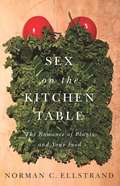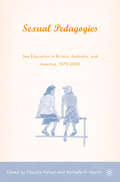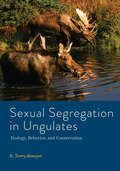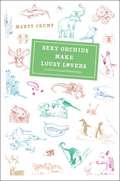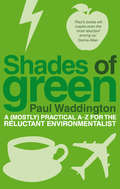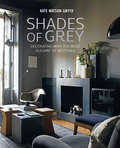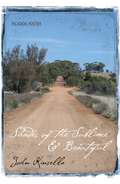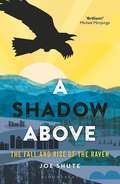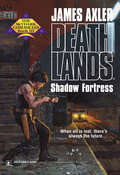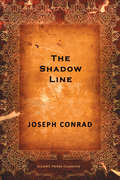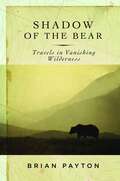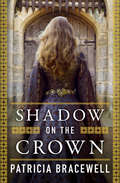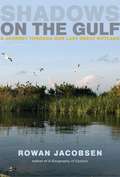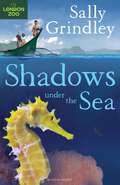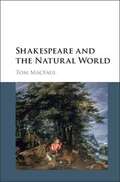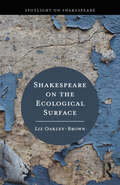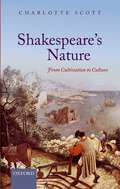- Table View
- List View
Sex on the Kitchen Table: The Romance of Plants and Your Food
by Norman C. EllstrandAt the tips of our forks and on our dinner plates, a buffet of botanical dalliance awaits us. Sex and food are intimately intertwined, and this relationship is nowhere more evident than among the plants that sustain us. From lascivious legumes to horny hot peppers, most of humanity’s calories and other nutrition come from seeds and fruits—the products of sex—or from flowers, the organs that make plant sex possible. Sex has also played an arm’s-length role in delivering plant food to our stomachs, as human handmade evolution (plant breeding, or artificial selection) has turned wild species into domesticated staples. In Sex on the Kitchen Table, Norman C. Ellstrand takes us on a vegetable-laced tour of this entire sexual adventure. Starting with the love apple (otherwise known as the tomato) as a platform for understanding the kaleidoscopic ways that plants can engage in sex, successive chapters explore the sex lives of a range of food crops, including bananas, avocados, and beets, finally ending with genetically engineered squash—a controversial, virus-resistant vegetable created by a process that involves the most ancient form of sex. Peppered throughout are original illustrations and delicious recipes, from sweet and savory tomato pudding to banana puffed pancakes, avocado toast (of course), and both transgenic and non-GMO tacos. An eye-opening medley of serious science, culinary delights, and humor, Sex on the Kitchen Table offers new insight into fornicating flowers, salacious squash, and what we owe to them. So as we sit down to dine and ready for that first bite, let us say a special grace for our vegetal vittles: let’s thank sex for getting them to our kitchen table.
Sex on the Kitchen Table: The Romance of Plants and Your Food
by Norman C. EllstrandAt the tips of our forks and on our dinner plates, a buffet of botanical dalliance awaits us. Sex and food are intimately intertwined, and this relationship is nowhere more evident than among the plants that sustain us. From lascivious legumes to horny hot peppers, most of humanity’s calories and other nutrition come from seeds and fruits—the products of sex—or from flowers, the organs that make plant sex possible. Sex has also played an arm’s-length role in delivering plant food to our stomachs, as human handmade evolution (plant breeding, or artificial selection) has turned wild species into domesticated staples. In Sex on the Kitchen Table, Norman C. Ellstrand takes us on a vegetable-laced tour of this entire sexual adventure. Starting with the love apple (otherwise known as the tomato) as a platform for understanding the kaleidoscopic ways that plants can engage in sex, successive chapters explore the sex lives of a range of food crops, including bananas, avocados, and beets, finally ending with genetically engineered squash—a controversial, virus-resistant vegetable created by a process that involves the most ancient form of sex. Peppered throughout are original illustrations and delicious recipes, from sweet and savory tomato pudding to banana puffed pancakes, avocado toast (of course), and both transgenic and non-GMO tacos. An eye-opening medley of serious science, culinary delights, and humor, Sex on the Kitchen Table offers new insight into fornicating flowers, salacious squash, and what we owe to them. So as we sit down to dine and ready for that first bite, let us say a special grace for our vegetal vittles: let’s thank sex for getting them to our kitchen table.
Sex on the Kitchen Table: The Romance of Plants and Your Food
by Norman C. EllstrandAt the tips of our forks and on our dinner plates, a buffet of botanical dalliance awaits us. Sex and food are intimately intertwined, and this relationship is nowhere more evident than among the plants that sustain us. From lascivious legumes to horny hot peppers, most of humanity’s calories and other nutrition come from seeds and fruits—the products of sex—or from flowers, the organs that make plant sex possible. Sex has also played an arm’s-length role in delivering plant food to our stomachs, as human handmade evolution (plant breeding, or artificial selection) has turned wild species into domesticated staples. In Sex on the Kitchen Table, Norman C. Ellstrand takes us on a vegetable-laced tour of this entire sexual adventure. Starting with the love apple (otherwise known as the tomato) as a platform for understanding the kaleidoscopic ways that plants can engage in sex, successive chapters explore the sex lives of a range of food crops, including bananas, avocados, and beets, finally ending with genetically engineered squash—a controversial, virus-resistant vegetable created by a process that involves the most ancient form of sex. Peppered throughout are original illustrations and delicious recipes, from sweet and savory tomato pudding to banana puffed pancakes, avocado toast (of course), and both transgenic and non-GMO tacos. An eye-opening medley of serious science, culinary delights, and humor, Sex on the Kitchen Table offers new insight into fornicating flowers, salacious squash, and what we owe to them. So as we sit down to dine and ready for that first bite, let us say a special grace for our vegetal vittles: let’s thank sex for getting them to our kitchen table.
Sex on the Kitchen Table: The Romance of Plants and Your Food
by Norman C. EllstrandAt the tips of our forks and on our dinner plates, a buffet of botanical dalliance awaits us. Sex and food are intimately intertwined, and this relationship is nowhere more evident than among the plants that sustain us. From lascivious legumes to horny hot peppers, most of humanity’s calories and other nutrition come from seeds and fruits—the products of sex—or from flowers, the organs that make plant sex possible. Sex has also played an arm’s-length role in delivering plant food to our stomachs, as human handmade evolution (plant breeding, or artificial selection) has turned wild species into domesticated staples. In Sex on the Kitchen Table, Norman C. Ellstrand takes us on a vegetable-laced tour of this entire sexual adventure. Starting with the love apple (otherwise known as the tomato) as a platform for understanding the kaleidoscopic ways that plants can engage in sex, successive chapters explore the sex lives of a range of food crops, including bananas, avocados, and beets, finally ending with genetically engineered squash—a controversial, virus-resistant vegetable created by a process that involves the most ancient form of sex. Peppered throughout are original illustrations and delicious recipes, from sweet and savory tomato pudding to banana puffed pancakes, avocado toast (of course), and both transgenic and non-GMO tacos. An eye-opening medley of serious science, culinary delights, and humor, Sex on the Kitchen Table offers new insight into fornicating flowers, salacious squash, and what we owe to them. So as we sit down to dine and ready for that first bite, let us say a special grace for our vegetal vittles: let’s thank sex for getting them to our kitchen table.
Sex on the Kitchen Table: The Romance of Plants and Your Food
by Norman C. EllstrandAt the tips of our forks and on our dinner plates, a buffet of botanical dalliance awaits us. Sex and food are intimately intertwined, and this relationship is nowhere more evident than among the plants that sustain us. From lascivious legumes to horny hot peppers, most of humanity’s calories and other nutrition come from seeds and fruits—the products of sex—or from flowers, the organs that make plant sex possible. Sex has also played an arm’s-length role in delivering plant food to our stomachs, as human handmade evolution (plant breeding, or artificial selection) has turned wild species into domesticated staples. In Sex on the Kitchen Table, Norman C. Ellstrand takes us on a vegetable-laced tour of this entire sexual adventure. Starting with the love apple (otherwise known as the tomato) as a platform for understanding the kaleidoscopic ways that plants can engage in sex, successive chapters explore the sex lives of a range of food crops, including bananas, avocados, and beets, finally ending with genetically engineered squash—a controversial, virus-resistant vegetable created by a process that involves the most ancient form of sex. Peppered throughout are original illustrations and delicious recipes, from sweet and savory tomato pudding to banana puffed pancakes, avocado toast (of course), and both transgenic and non-GMO tacos. An eye-opening medley of serious science, culinary delights, and humor, Sex on the Kitchen Table offers new insight into fornicating flowers, salacious squash, and what we owe to them. So as we sit down to dine and ready for that first bite, let us say a special grace for our vegetal vittles: let’s thank sex for getting them to our kitchen table.
Sexual Pedagogies: Sex Education in Britain, Australia, and America, 1879–2000
by C. Nelson M. MartinUnderstandings of sexuality and sex education have changed dramatically, and in this collection, the authors explore the various texts that were used to teach, to entertain, to sanction and to form a sexual standard for a nation. According to Nelson and Martin, these include a puberty education, sermons on abstinence, medical writings promoting sexual fulfillment, Hollywood comedies about sexual coming of age and picture books validating homosexuality. The essays included here are designed to illustrate the many responses that Anglophone culture has had to such texts for over a century.
Sexual Segregation in Ungulates: Ecology, Behavior, and Conservation (Wildlife Management and Conservation)
by R. Terry BowyerWhy does it benefit some male and female animals to live separately?Sexual segregation, wherein the sexes of a species live apart for long periods of time, has far-reaching consequences for the ecology, behavior, and conservation of hooved mammals, which are called ungulates. Award-winning researcher R. Terry Bowyer has spent the past four decades unravelling the causes and consequences of this perplexing phenomenon by studying ungulates and the large carnivores that prey upon them. In Sexual Segregation in Ungulates, Bowyer's critical, thought-provoking approach helps resolve long-standing disagreements concerning sexual segregation and offers future pathways for species and habitat conservation. He highlights important elements of the natural history of wild ungulate species, including bighorn sheep and elk. He then uses this perspective to frame and test hypotheses illuminating the motivations behind sexual segregation. He investigates the role of sexual segregation in mechanisms underpinning ungulate mating systems, sexual dimorphism, paternal behavior, and population dynamics. Bowyer's research spans ecosystems from deserts to the Arctic and involves most species of ungulates inhabiting the North American continent. He also provides a timely review of sexual segregation for species of plants and other animals, including humans. Covering definitions, theory, findings, and practical applications of related study, Bowyer describes the behavioral patterns related to sexual segregation, explains how to detect these patterns, and considers the implications of sexual segregation for new approaches to conservation and management of ungulates and other species of wildlife.This book is essential reading for scientists and all those interested in the conservation and management of species, including wildlife professionals, hunters, outdoor enthusiasts, and naturalists.
Sexual Segregation in Ungulates: Ecology, Behavior, and Conservation (Wildlife Management and Conservation)
by R. Terry BowyerWhy does it benefit some male and female animals to live separately?Sexual segregation, wherein the sexes of a species live apart for long periods of time, has far-reaching consequences for the ecology, behavior, and conservation of hooved mammals, which are called ungulates. Award-winning researcher R. Terry Bowyer has spent the past four decades unravelling the causes and consequences of this perplexing phenomenon by studying ungulates and the large carnivores that prey upon them. In Sexual Segregation in Ungulates, Bowyer's critical, thought-provoking approach helps resolve long-standing disagreements concerning sexual segregation and offers future pathways for species and habitat conservation. He highlights important elements of the natural history of wild ungulate species, including bighorn sheep and elk. He then uses this perspective to frame and test hypotheses illuminating the motivations behind sexual segregation. He investigates the role of sexual segregation in mechanisms underpinning ungulate mating systems, sexual dimorphism, paternal behavior, and population dynamics. Bowyer's research spans ecosystems from deserts to the Arctic and involves most species of ungulates inhabiting the North American continent. He also provides a timely review of sexual segregation for species of plants and other animals, including humans. Covering definitions, theory, findings, and practical applications of related study, Bowyer describes the behavioral patterns related to sexual segregation, explains how to detect these patterns, and considers the implications of sexual segregation for new approaches to conservation and management of ungulates and other species of wildlife.This book is essential reading for scientists and all those interested in the conservation and management of species, including wildlife professionals, hunters, outdoor enthusiasts, and naturalists.
Sexy Orchids Make Lousy Lovers: & Other Unusual Relationships
by Marty CrumpVampire bats that regurgitate blood for roosting buddies. Mosquitoes that filch honeydew droplets from ants. Reptiles that enforce chastity on their lovers with copulatory plugs. Capuchin monkeys that use millipede secretions as mosquito repellent. The natural world is full of unusual relationships, and negotiation between life-forms striving to survive is evolution at its most diverse, entertaining, and awe-inspiring. Picking up where her highly popular Headless Males Make Great Lovers left off, tropical field biologist Marty Crump takes us on another voyage of discovery into the world of unusual natural histories, this time focusing on extraordinary interactions involving animals, plants, fungi, and bacteria. Sexy Orchids Make Lousy Lovers& Other Unusual Relationships illuminates the ceaseless give-and-take between species. Occasionally, both interacting parties benefit, like when hornbills and dwarf mongooses hunt together for food. Other times, like when mites ride in hummingbirds’ nostrils to reach their next meal of nectar, one individual benefits and the other is neither helped nor harmed. But sometimes one individual benefits at the expense of the other; you need only recall your last sinus infection to understand how that works. Throughout, Crump brings her trademark spunk and zest to these stories of intimate exchange. She introduces readers to penguins that babysit, pseudoscorpions that ride and mate under the wings of giant harlequin beetles, and parasitic fungi that bend insects to their will. A lively companion to Crump’s earlier work, Sexy Orchids Make Lousy Lovers& Other Unusual Relationships captures the bizarre and befuddling aspects of the behavior of animals, plants, and microbes. After this entertaining romp through the world of natural relationships, you’ll never look at an orchid the same way again.
Sexy Orchids Make Lousy Lovers: & Other Unusual Relationships
by Marty CrumpVampire bats that regurgitate blood for roosting buddies. Mosquitoes that filch honeydew droplets from ants. Reptiles that enforce chastity on their lovers with copulatory plugs. Capuchin monkeys that use millipede secretions as mosquito repellent. The natural world is full of unusual relationships, and negotiation between life-forms striving to survive is evolution at its most diverse, entertaining, and awe-inspiring. Picking up where her highly popular Headless Males Make Great Lovers left off, tropical field biologist Marty Crump takes us on another voyage of discovery into the world of unusual natural histories, this time focusing on extraordinary interactions involving animals, plants, fungi, and bacteria. Sexy Orchids Make Lousy Lovers& Other Unusual Relationships illuminates the ceaseless give-and-take between species. Occasionally, both interacting parties benefit, like when hornbills and dwarf mongooses hunt together for food. Other times, like when mites ride in hummingbirds’ nostrils to reach their next meal of nectar, one individual benefits and the other is neither helped nor harmed. But sometimes one individual benefits at the expense of the other; you need only recall your last sinus infection to understand how that works. Throughout, Crump brings her trademark spunk and zest to these stories of intimate exchange. She introduces readers to penguins that babysit, pseudoscorpions that ride and mate under the wings of giant harlequin beetles, and parasitic fungi that bend insects to their will. A lively companion to Crump’s earlier work, Sexy Orchids Make Lousy Lovers& Other Unusual Relationships captures the bizarre and befuddling aspects of the behavior of animals, plants, and microbes. After this entertaining romp through the world of natural relationships, you’ll never look at an orchid the same way again.
Shades Of Green: A (mostly) practical A-Z for the reluctant environmentalist
by Paul WaddingtonFew of us have what it takes to go 'all the way' on the green scale. Yet as fears about the food chain, climate change, plummeting biodiversity and the sustainability of our current lifestyles take hold, wouldn't it be good to be clear about our range of options?Whether you are pondering bicycles or baths, holidays or heating, pets or pasta, washing dishes or wine, Shades of Green is the book for you. It's an easy-to-use, A-Z guide which sets out your choices on a scale from 'completely green' to 'not even a little bit green'. No preaching. No finger-wagging.Whether you're an eco-warrior or a planet-trasher or, like most of us, something in between, Shades of Green will give you all you need to know so you can choose what suits you best. This is essential and often surprising reading.
Shades of Grey: Decorating With The Most Elegant Of Neutrals
by Kate Watson-SmythCrammed with fascinating facts, expert advice and a wealth of essential information, Shades of Grey will guide you through the minefield that is choosing exactly the right shade of grey paint.
Shades of the Sublime & Beautiful
by John KinsellaAustralian John Kinsella is one of the most highly regarded poets currently writing in English. Taking Edmund Burke’s 250-year old masterpiece A Philosophical Enquiry into the Origin of Our Ideas of the Sublime and Beautiful as his template, Kinsella has produced his most accomplished and broadly representative work to date. Shades of the Sublime & Beautiful is a warm, human, anecdotally rich book, concentrating many of the themes that have obsessed its author over the last twenty years: language, love, the invocation of place, the mysteries of the Australian wilderness, and our mediations between the human and natural realms. Together, these lyric meditations build towards a profound thesis on the ecology of the imagination, and are always conducted in concrete, vivid and exuberant language that is unmistakably Kinsella’s own. ‘Kinsella’s poems are a very rare feat: they are narratives of feeling. Vivid sight – of landscapes, of animals, of human forms in distant light – becomes insight. There is, often, the shock of the new. But somehow awaited, even familiar. Which is the homecoming of a true poet’ George Steiner ‘John Kinsella is an Orphic fountain, a prodigy of the imagination . . . he frequently makes me think of John Ashbery: improbable fecundity, eclecticism, and a stand that fuses populism and elitism in poetic audience’ Harold Bloom
A Shadow Above: The Fall and Rise of the Raven
by MR Joe ShuteFor millennia, we have tried to explain ourselves using the raven as a symbol. It occupies a unique place in British history and has left an indelible mark on our cultural landscape. The raven's hulking black shape has come to represent many things: death, all-seeing power, the underworld, and a wildness that remains deep within us. Legend has it that the fate of the nation rests upon the raven, and should the resident birds ever leave the Tower of London then the entire kingdom will fall. While so much of our wildlife is vanishing, ravens are returning to their former habitats after centuries of exile, moving back from their outposts at the very edge of the country, to the city streets from which they once scavenged the bodies of the dead. In A Shadow Above, Joe Shute follows ravens across their new hunting grounds, examining our complicated and challenging relationship with these birds. He meets people who live alongside the raven in conflict and peace, unpicks their fierce intelligence, and ponders what the raven's successful return might come to symbolise for humans in the dark times we now inhabit.
Shadow Fortress
by James AxlerA planet ravaged by the apocalyptic blast of 2001 gave birth to a new world of savagery–and a new breed of hero.
The Shadow Line
by Joseph ConradThe Shadow-Line is a short novel based at sea by Joseph Conrad. The novella depicts the development of a young man upon taking a captaincy in the Orient, with the shadow line of the title representing the threshold of this development. The novella has often been cited as a metaphor of the First World War, given its timing and references to a long struggle, the importance of camaraderie, etc.
Shadow of the Bear: Travels in Vanishing Wilderness
by Brian PaytonWe've been meeting bears in the wilderness, and in our dreams, since the dawn of human history. Celebrated in art and myth since we began drawing on the walls of caves, they cast a long shadow over our collective subconscious. Wherever bears endure, they are an indicator of the health of their ecosystem. Their decline-some to the edge of extinction-foretells a bigger story: that of our planet's peril. In a series of remarkable journeys, Brian Payton travels the world in search of the eight remaining bear species. Along the way, he confronts poachers in the jungles of Cambodia, witnesses the cruelty of the bear bile trade in China, and delves into the politics of panda sex. From the reclusive spectacled bears of Peru to the man-eating sloth bears of India, Payton captures the power and beauty of these fascinating creatures while exploring their unique place within very different cultures. Vivid characters, exotic landscapes, and deft storytelling make for an unforgettable trek down the braided path of bear and human history.
Shadow on the Crown: A Novel (The Emma of Normandy #1)
by Patricia BracewellSet in England when Vikings are on the brink of invasion, this is an epic tale of seduction, war, and unrequited love from an outstanding new voice in historical fiction
Shadows on the Gulf: A Journey Through Our Last Great Wetland
by Rowan JacobsenIn the spring of 2010, we watched oil gushing unstoppably into the waters of the Gulf of Mexico. But as bad as the spill was, it is only the latest chapter in a century-long story of destruction. At the height of BP's dispersant madness, the amount sprayed each day merely equaled the amount of dispersant that washes down the Mississippi from the Heartland's dishwashers and washing machines. Coastal drilling has damaged the region's ecology far more than offshore drilling. And the acres of marshland ruined by oil slicks can't compare to the amount that disappears in every hurricane, due to the work of the Army Corps of Engineers. Southern Louisiana is subsiding. Even if we succeed in restoring every mile of beach and wetland from the oil spill, the entire Mississippi Delta could be lost this century, and New Orleans will sink beneath the waves, an American Atlantis.Surveying the Gulf Coast by sailboat, skiff, car, and kayak, Jacobsen journeys from the bayous of Terrebonne Parish, to the last shucking house in New Orleans's French Quarter. He discovers a little-appreciated ecological wonder of breathtaking natural beauty and rich culture struggling to hold on to the things that have always sustained it.Shadows on the Gulf details the catastrophe creeping across the region and reveals why the damage to the Gulf will affect us all. Not only are the Gulf's wetlands the best oyster reefs and fish nurseries in the world, they also provide critical habitat to most of America's migratory songbirds and waterfowl. If the Gulf is allowed to fail, the effects will ripple across America.
Shadows under the Sea
by Sally GrindleyTwo children accompany their parents as they travel the world helping animals on the verge of extinction. As their parents work alongside international agencies, the children have their own thrilling adventures.In this book, Joe, his sister Aesha and their parents travel to a remote island in the Philippines to take part in an intriguing seahorse project in a marine protected area. Joe befriends Dario, a local boy, and as they explore the island, Joe unravels the identity of the criminals who've been dynamite fishing and damaging the fragile coral reefs nearby.Exciting snorkelling trips, snapshots of island life and a thrilling chase scene are all featured in an exotic setting. Plenty of information is included on marine life, such as seahorses, mangrove sharks and reef fish. Shadows under the Sea is written with the assistance and guidance of London Zoo's conservation team. All information is accurate and the stories are full of excitement and tension.Sally Grindley is the author of bestselling and award-winning fiction for young readers. Here she brings to life a story of intrigue set on a Filipino island.
Shakespeare And The Natural World (PDF)
by Tom MacFaulExploring the rich range of meanings that Shakespeare finds in the natural world, this book fuses ecocritical approaches to Renaissance literature with recent thinking about the significance of religion in Shakespeare's plays. MacFaul offers a clear introduction to some of the key problems in Renaissance natural philosophy and their relationship to Reformation theology, with individual chapters focusing on the role of animals in Shakespeare's universe, the representation of rural life, and the way in which humans' consumption of natural materials transforms their destinies. These discussions enable powerful new readings of Shakespeare's plays, including A Midsummer Night's Dream, As You Like It, King Lear, Macbeth, The Tempest, The Winter's Tale, and the history plays. Proposing that Shakespeare's representation of the relationship between man and nature anticipated that of the Romantics, this volume will interest scholars of Shakespeare studies, Renaissance drama and literature, and ecocritical studies of Shakespeare.
Shakespeare on the Ecological Surface (Spotlight on Shakespeare)
by Liz Oakley-BrownShakespeare on the Ecological Surface uses the concept of the ‘surface’ to examine the relationship between contemporary performance and ecocriticism. Each section looks, in turn, at the 'surfaces' of slick, smoke, sky, steam, soil, slime, snail, silk, skin and stage to build connections between ecocriticism, activism, critical theory, Shakespeare and performance. While the word ‘surface’ was never used in Shakespeare’s works, Liz Oakley-Brown shows how thinking about Shakespearean surfaces helps readers explore the politics of Elizabethan and Jacobean culture. She also draws surprising parallels with our current political and ecological concerns. The book explores how Shakespeare uses ecological surfaces to help understand other types of surfaces in his plays and poems: characters’ public-facing selves; contact zones between characters and the natural world; surfaces upon which words are written; and physical surfaces upon which plays are staged. This book will be an illuminating read for anyone studying Shakespeare, early modern culture, ecocriticism, performance and activism.
Shakespeare on the Ecological Surface (Spotlight on Shakespeare)
by Liz Oakley-BrownShakespeare on the Ecological Surface uses the concept of the ‘surface’ to examine the relationship between contemporary performance and ecocriticism. Each section looks, in turn, at the 'surfaces' of slick, smoke, sky, steam, soil, slime, snail, silk, skin and stage to build connections between ecocriticism, activism, critical theory, Shakespeare and performance. While the word ‘surface’ was never used in Shakespeare’s works, Liz Oakley-Brown shows how thinking about Shakespearean surfaces helps readers explore the politics of Elizabethan and Jacobean culture. She also draws surprising parallels with our current political and ecological concerns. The book explores how Shakespeare uses ecological surfaces to help understand other types of surfaces in his plays and poems: characters’ public-facing selves; contact zones between characters and the natural world; surfaces upon which words are written; and physical surfaces upon which plays are staged. This book will be an illuminating read for anyone studying Shakespeare, early modern culture, ecocriticism, performance and activism.
Shakespeare's Nature: From Cultivation To Culture
by Charlotte ScottShakespeare's Nature offers the first sustained account of the impact of the language and practice of husbandry on Shakespeare's work. It shows how the early modern discourse of cultivation changes attitude to the natural world, and traces the interrelationships between the human and the natural worlds in Shakespeare's work through dramatic and poetic models of intervention, management, prudence and profit. Ranging from the Sonnets to The Tempest, the book explains how cultivation of the land responds to and reinforces social welfare, and reveals the extent to which the dominant industry of Shakespeare's time shaped a new language of social relations. Beginning with an examination of the rise in the production of early modern printed husbandry manuals, Shakespeare's Nature draws on the varied fields of economic, agrarian, humanist, Christian and literary studies, showing how the language of husbandry redefined Elizabethan attitudes to both the human and non-human worlds. In a series of close readings of specific plays and poems, this book explains how cultivation forms and develops social and economic value systems, and how the early modern imagination was dependent on metaphors of investment, nurture and growth. By tracing this language of intervention and creation in Shakespeare's work, this book reveals a fundamental discourse in the development of early modern social, political and personal values.
Shakespeare’s Things: Shakespearean Theatre and the Non-Human World in History, Theory, and Performance (Perspectives on the Non-Human in Literature and Culture)
by Brett Gamboa Lawrence SwitzkyFloating daggers, enchanted handkerchiefs, supernatural storms, and moving statues have tantalized Shakespeare’s readers and audiences for centuries. The essays in Shakespeare’s Things: Shakespearean Theatre and the Non-Human World in History, Theory, and Performance renew attention to non-human influence and agency in the plays, exploring how Shakespeare anticipates new materialist thought, thing theory, and object studies while presenting accounts of intention, action, and expression that we have not yet noticed or named. By focusing on the things that populate the plays—from commodities to props, corpses to relics—they find that canonical Shakespeare, inventor of the human, gives way to a lesser-known figure, a chronicler of the ceaseless collaboration among persons, language, the stage, the object world, audiences, the weather, the earth, and the heavens.
